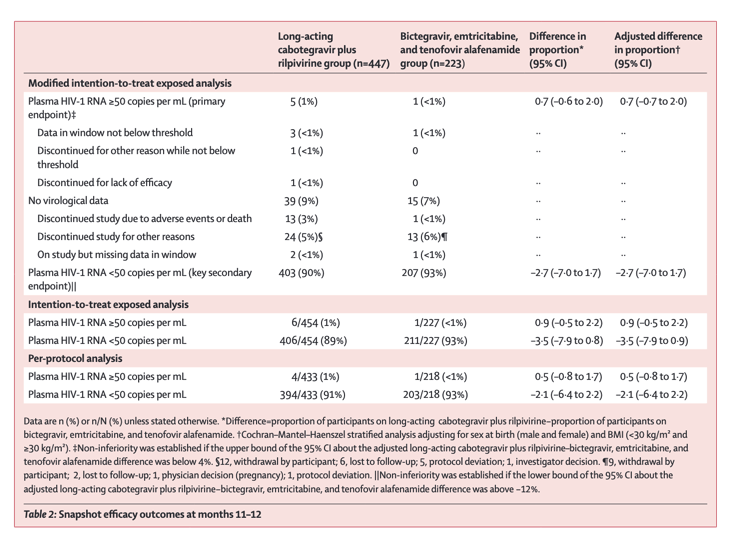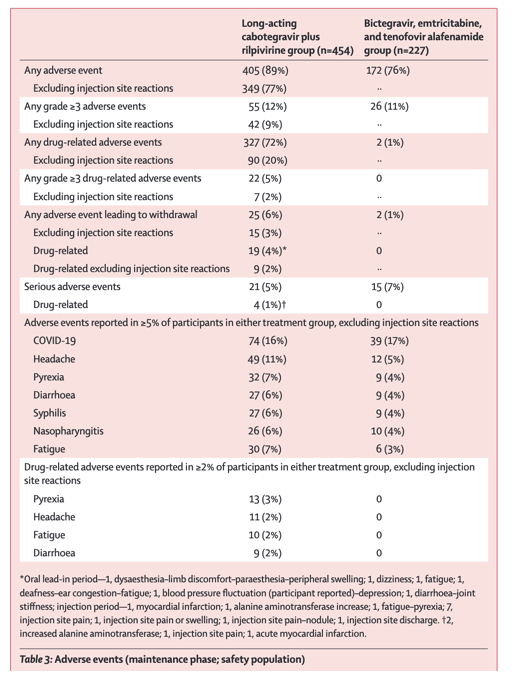| |
Efficacy, safety, and tolerability of switching to long-acting cabotegravir plus rilpivirine versus continuing fixed-dose bictegravir, emtricitabine, and tenofovir alafenamide in virologically suppressed adults with HIV, 12-month results (SOLAR): a randomised, open-label, phase 3b, non-inferiority trial. Commentary.
|
| |
| |
Summary
Background
Download the PDF here
Download the PDF here
Cabotegravir plus rilpivirine is the only approved complete long-acting regimen for the maintenance of HIV-1 virological suppression dosed every 2 months. The SOLAR study aimed to compare long-acting cabotegravir plus rilpivirine every 2 months with continued once-daily bictegravir, emtricitabine, and tenofovir alafenamide for the maintenance of HIV-1 virological suppression in adults living with HIV.
Methods
SOLAR is a randomised, open-label, multicentre, phase 3b, non-inferiority study. The study was done in 118 centres across 14 countries. Participants with HIV-1 RNA less than 50 copies per mL were randomly assigned (2:1), stratified by sex at birth and BMI, to either long-acting cabotegravir (600 mg) plus rilpivirine (900 mg) dosed intramuscularly every 2 months or to continue daily oral bictegravir (50 mg), emtricitabine (200 mg), and tenofovir alafenamide (25 mg). Participants randomly assigned to long-acting therapy had a choice to receive cabotegravir (30 mg) plus rilpivirine (25 mg) once daily as an optional oral lead-in for approximately 1 month. The primary efficacy endpoint was the proportion of participants with virological non-response (HIV-1 RNA ≥50 copies per mL; the US Food and Drug Administration snapshot algorithm, 4% non-inferiority margin; modified intention-to-treat exposed population) at month 11 (long-acting start with injections group) and month 12 (long-acting with oral lead-in group and bictegravir, emtricitabine, and tenofovir alafenamide group). The study is registered with ClinicalTrials.gov, NCT04542070, and is ongoing.
Findings
837 participants were screened between Nov 9, 2020, and May 31, 2021, and 687 were randomly assigned to switch treatment or continue existing treatment. Of 670 participants (modified intention-to-treat exposed population), 447 (67%) switched to long-acting therapy (274 [61%] of 447 start with injections; 173 [39%] of 447 with oral lead-in) and 223 (33%) continued bictegravir, emtricitabine, and tenofovir alafenamide. Baseline characteristics were similar; median age was 37 years (range 18-74), 118 (18%) of 670 were female sex at birth, 207 (31%) of 670 were non-White, and median BMI was 25⋅9 kg/m2 (IQR 23⋅3-29⋅5).
At month 11-12, long-acting cabotegravir plus rilpivirine showed non-inferior efficacy versus bictegravir, emtricitabine, and tenofovir alafenamide (HIV-1 RNA ≥50 copies per mL, five [1%] of 447 vs one [<1%] of 223), with an adjusted treatment difference of 0⋅7 (95% CI -0⋅7 to 2⋅0).
Excluding injection site reactions, adverse events and serious adverse events were similar between groups. No treatment-related deaths occurred. More long-acting group participants had adverse events leading to withdrawal (25 [6%] of 454 vs two [1%] of 227). Injection site reactions were reported by 316 (70%) of 454 long-acting participants; most (98%) were grade 1 or 2.
Interpretation
These data support the use of long-acting cabotegravir plus rilpivirine dosed every 2 months as a complete antiretroviral regimen that has similar efficacy to a commonly used integrase strand transfer inhibitor-based first-line regimen, while addressing unmet psychosocial issues associated with daily oral treatment.
Funding
ViiV Healthcare.


|
|
| |
| |
|
|
|